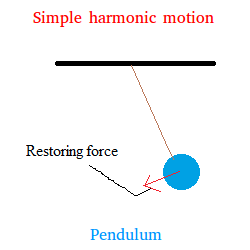Simple harmonic motion
There is a difference between simple harmonic motion and harmonic motion. What is a harmonic motion?
Any motion that repeats itself at regular intervals is called harmonic motion or periodic motion.
Examples of harmonic motion include a satellite orbiting around the earth or the earth revolving around the sun.
The above examples are harmonic for two reasons.
- First, the object will return to its original position or the location where it started. We call this situation cycles.
- Second, the object will take a certain amount of time to get back to the location where it started. The time it takes to get back where it started is called period and T is used to represent the period.
It takes the earth 365 and 1/4 days to orbit the sun. The period is 365 and 1/4 days.
Any vibration is a harmonic motion because it involves movements that repeat themselves at regular intervals. However, not every vibration is a simple harmonic motion as we shall see next.
What is a simple harmonic motion?
A simple harmonic motion (SHM) is a special case of harmonic motion. A simple harmonic motion is a back and forth motion and it always requires a restoring force and the restoring force is proportional to the displacement from equilibrium.
What is a restoring force? A restoring force is a force that brings an object back to its equilibrium position. The pendulum below is at its equilibrium point.

However, what will happen if I move it to the right or to the left? The
restoring force shown with the red arrow in the figure below will try to bring it back to
equilibrium point. In fact the restoring force is the force that makes
the pendulum swing back and forth. Keep in mind also that in simple harmonic motion, the
displacement to the right or to the left also called amplitude must not
be too big. In other words, if you move the ball to the right too much,
it will not give you a simple harmonic motion.

The restoring force always points to the equilibrium position. If the ball was on the left, the restoring force will point to the right.
We also said that in simple harmonic motion, the restoring force is proportional to the displacement from equilibrium. What does that mean? This is Hooke's law explained in this lesson about elasticity.
Basically, the bigger the restoring force, the bigger the displacement.
A pendulum clock is a great example of simple harmonic motion. However, a bouncing ball is not a simple harmonic motion. The pendulum will always go back where it started. However, the bouncing ball will never bounce back to the height it was released.